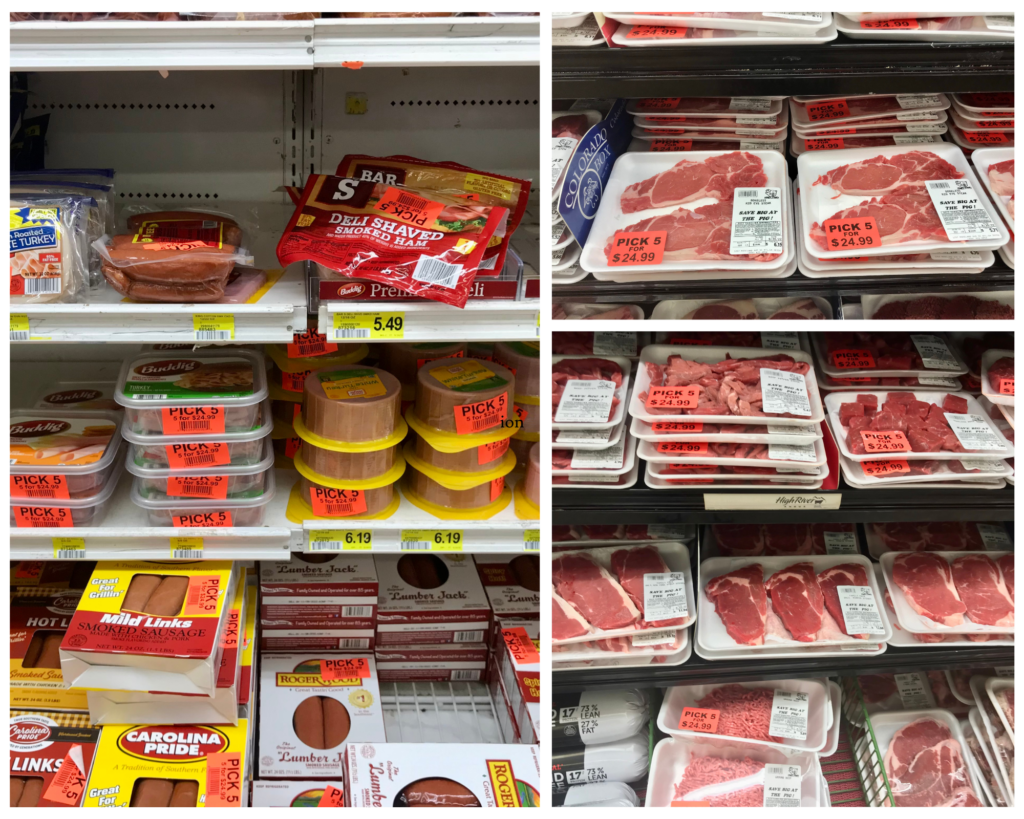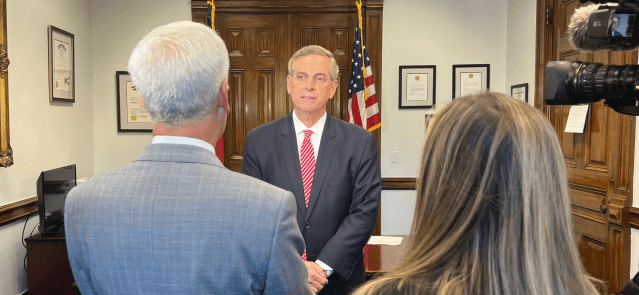Stay ahead of the curve as a political insider with deep policy analysis, daily briefings and policy-shaping tools.
Request a DemoCan we take the gas out of inflation in Georgia?

The Gist
Inflation — the increasing cost of goods and services — is causing pain and busting budgets across the country, and even more so for people in Georgia. While the Feds play the long game with interest rates, recent efforts by Gov. Brian Kemp and the state to control inflation so far are low impact, but good for morale.
What’s Happening
Over the last year, the rate of inflation has risen 8.3 percent in the U.S., 10.9 percent in Georgia, and 11.7 percent in metro Atlanta. The cost of groceries, fuel and housing is contributing mightily to the sticker shock that consumers are experiencing. Driving up those costs is an increased demand for all kinds of products by Americans, at a time when employment is high and the global supply chain is stressed.

“A hundred dollars just doesn’t go as far now,” says Ronekia Earley, 29, who was shopping at Piggly Wiggly in southeast Atlanta with her fiancé, Tereze Fortson, 30, and their son Aiden, 9, this week. They have three more children, ages 5 months, 1 and 3-years-old. “What used to last a month now only lasts two or three weeks,” she said. Their cart included packages of pork chops, chicken wings and a jar of mayonnaise with ‘Pick 5 for $24.99’ stickers.
“It used to be ‘Pick 5 for $19.99,’” said Fortson. “They’re shrinking the deal that we depend on.”

Last week, Federal Reserve Bank officials moved to flatten the spike in inflation nationwide by once more raising benchmark interest rates —now at 3% to 3.25% (the highest since 2008). The Federal Reserve will likely increase rates to 4.5% before they’re done raising them next year. This ongoing action by the Fed is expected to drive down demand for vehicles, housing and fuel, and put a damper on spending overall. It also greases the skids to an economic recession, according to many experts.
Earlier this month, Gov. Kemp continued his effort to curb inflation in Georgia by renewing executive orders to temporarily suspend fuel taxes, and relaxing some regulations related to supply chain management – chiefly around how long truck drivers can be on the road, and the size of the loads they can carry. These orders kicked off in March and now extend to Oct. 12.
The impacts of both orders by Kemp “are small, they’re at the margins,” says Marty Parker, a lecturer and supply chain expert at the University of Georgia. “But when you’re talking about a person living on a fixed income, or a business trying to manage a supply chain, the margins are important.”
Parker and other economic experts estimate that with the suspension of the 29.1 cents per gallon state gas tax, the average consumer in Georgia is saving $12 to $15 a month on gas.
That monthly fuel savings “is okay, a little something I put in my son’s piggy bank, to save it for when we might really need it,” said Earley, who works as a school janitor in Atlanta.
The state tax savings on diesel fuel — at 32.6 cents per gallon — can add up to more for small business owners, especially those operating their own trucks or fleets.
Maurice Garard, an owner-operator long haul truck driver based in McDonough, frequently drives several hundred miles at a time. This week at a QT truck fueling station in Forest Park, he filled up his rig stocked with dog food bound for Dallas. At $4.49 per gallon of diesel, he spent $706.69 for 157 gallons, saving $51.18 in state fuel tax.
Garard estimates he saves several hundred dollars a month from the diesel tax break, but said more relief has come from the steady drop in fuel prices since June, when diesel fuel peaked at $5.80 per gallon.
“Diesel prices coming down is critical, and props to the governor for his part in that,” said Garard. “But the cost of everything else is still really high. And if you need to repair your truck, good luck. There’s not enough parts in the market, or mechanics to do repairs.”
Garard said he recently spent $30,000 to have the motor rebuilt on his 53-foot Peterbilt truck, paying a mechanic $150 an hour. He also replaced a fuel pump for $6,000. In both cases he had weeks of down time with no income, while waiting for the repairs to be completed.
He said longer wait times at distribution points are also costing him. On this day he had waited six hours for workers at the Blue Buffalo dog food warehouse in McDonough to load his truck. Recently he waited for 15 hours at a Pilgrim’s Pride chicken plant in south Georgia, while he sat with his refrigerated diesel truck running. Garard estimates that with all of his increased expenses this year, his net income will drop from $230,000 in 2021 to less than $100,000 this year.
The challenges that Garard described are now commonplace in the transportation and distribution industries, said Parker, the supply chain expert. “When a system begins to reach its limits of capacity, the wait times become exponential – and costly.”

Why It Matters
Bottlenecks at the ports of Savannah and Brunswick have caused long delays of shipments of all sorts of goods, and disruptions in supply chains across Georgia and elsewhere for well over a year. The “dwell time” of large containers sitting on ships docked at ports, waiting to be loaded onto trailer trucks and delivered to their final destinations, has improved recently with the construction of 20 percent more container and warehouse space this year. The ports are still congested, but cargo fluidity is improving. Dwell times for imported shipments at Georgia ports currently average 9.35 days; six months ago, they averaged 11.38 days, according to the Georgia Ports Authority.
Beyond the ports, at nearshore warehouses and corporate distribution facilities further inland, storage capacity and the skilled labor needed to keep the goods moving is not sufficient to meet pent-up demand that began during the pandemic.
“We’ve been at 95 percent to 98 percent capacity through COVID,” said Parker. “All of the orders were delayed, and then suddenly started coming in, and we didn’t have anywhere to put the stuff.” He said this “bullwhip effect” – when transitory increases in demand cause suppliers and retailers to over-order and push more inventory into the pipeline than future demand can support – accounts for the currently overwhelmed supply chain system, and higher prices for many items.
Ironically, says Parker, the robust and healthy Georgia economy is part of the inflationary trend. Georgia’s near record low 3 percent unemployment rate and continuing revenue growth – income taxes are currently running 10 percent ahead of last year – are perpetuating an economic boom.
“The Atlanta and Georgia economies have outperformed the national economy for over a year, “ he said. “When you’re doing well, and have more jobs than people to fill them, then it’s a double-edged sword. It leads to the kind of shortages and scarcity that then leads to higher prices.”

Competing Economic Prescriptions on the Campaign Trail
Both Gov. Kemp and his Democratic challenger Stacey Abrams are touting their economic plans and prescriptions to curb inflation as a way to appeal to Georgia voters, who cite the cost of living and concerns about the economy as their top issues in recent polls.
When Kemp renewed his two executive orders this month, he said in a statement, “With our nation experiencing 40-year high inflation, ongoing supply chain challenges, and some of the highest gas prices ever, Democrats in D.C. continue to spend taxpayer money with no regard for the costs and its impact on hardworking families … While these politicians continue to double down on bad policies, we are using the means available to us to provide much-needed relief to Georgians. As I’ve said since we first suspended the fuel tax back in March, we can’t fix everything Washington has broken, but we can use the resources we have as a result of our responsible budgeting to keep more money in the pockets of hardworking Georgians.”
Kemp plans to return $2 billion of the $6.7 billion fiscal year 2022 surplus to Georgians in the form of state income tax rebates — which would give $250 to single filers and $500 to married couples — and property tax breaks, which would average about $500 per homeowner.
Two weeks ago, Abrams appeared on the ABC talk show “The View” and said, when asked about her fix for inflation, “The goal is not only to bring down prices, but to bring up wages. Georgia is one of the lowest wage states in the nation. And although we have more jobs coming in, those jobs are often low-wage jobs that you have to have two or three of to make a living.”
She promoted her plan to expand Medicaid, which she has said repeatedly on the campaign trail would insure more than 500,000 Georgians currently lacking coverage and create 64,000 new jobs in Georgia. And she pledged to return $1 billion of the 2022 surplus to Georgia taxpayers, “but cap it at those who make $250,000 or less, instead of giving the bulk of money to the wealthiest Georgians.”
What’s Next
“The truth is, there’s no easy way to tame inflation,” said Parker. “There’s always going to be some amount of pain involved. And it’s really at a federal level where you control these levers. States have a limit on what they can do. Giving back a surplus will only help people on a short-term basis.”
In presenting his economic forecast for Georgia and the nation last month, Rajeev Dhawan of the Economic Forecasting Center at Georgia State University said, “Curing inflation will be a year and a half process,” and that a “very determined” Federal Reserve will “eliminate excess demand by hiking interest rates sufficiently.” He predicted that Consumer Price Index inflation rates will average 8.2 percent by the end of 2022, moderate to 4.3 percent in 2023, and settle down to 2.0 percent in 2024.
The pain coming to consumers and employers along the way will manifest in the form of slower job growth and an economic recession, locally and nationally, he said.
“The energy-price-hike-induced inflation has cratered consumer confidence” across the nation, Dhawan said, “signaling less spending in coming months.” He predicts job growth in the U.S. will drop sharply from its 496,000 monthly pace in the first half of 2022 to 165,000 in monthly job losses by mid-2023.
Georgia’s economy, on the other hand, will continue to outperform the U.S. economy, he said, noting that Georgia’s economy is currently buoyed by its low unemployment rate and “superb job growth,” adding 137,400 jobs in the past seven months, led by the hospitality and retail sectors. But “the biggest stumbling block for growth” in those sectors, said Dhawan, will not be rising interest rates, but a shortage of workers to meet the sectors’ “blistering growth rate.” He predicted the robust pace of job growth in Georgia manufacturing (44,000 this year) will also slow, as the increased cost of energy caused by Russia’s invasion of Ukraine continues to take its toll.
Overall, he said, the state will gain fewer jobs in 2023 (52,200) than in 2022 (176,200). However, Georgia will still show positive growth, unlike the nation as a whole.
“Labor issues are not getting better any time soon,” said Parker, who agrees that “a shock to the economy” is coming soon in the form of ever-higher interest rates. “The big question is, will it be a soft or a hard landing?”
Join the Conversation
What do you want to know about inflation and the Georgia economy? Share your thoughts by emailing [email protected] or on Twitter @journalistajill.
Follow Key Players for This Story:
Food Costs and Consumer Price Index rates – U.S. Bureau of Labor Statistics, USDA Agricultural Marketing Service, National Statistics Office of Georgia
Gas Prices – AAA Gas Prices
Martin Parker, Lecturer, Supply Chain Management at University of Georgia, Terry College of Business
Rajeev Dhawan, Chair of Economic Forecasting, Economic Forecasting Center of Georgia State University, Robinson College of Business
***
Header photo: Maurice Garard, an owner-operator long haul truck driver based in McDonough, filling up his truck with gas at the QT truck fueling station in Forest Park this week. (Credit: Jill Jordan Sieder for State Afffairs)
Newly minted Senate Minority Leader Harold Jones II: ‘I’m not the typical back-slapping politician’
Nearly 10 years into legislative life, Sen. Harold Jones II wouldn’t change anything about the experience. “I love every minute of it. Even when I hate it, I love it,” the 55-year-old Augusta Democrat told State Affairs. Come January, Jones will add another role to his legislative duties: Senate minority leader, a job held for …
Gov. Kemp calls on state agencies to be fiscally restrained amid record $16.5B surplus
The Gist Gov. Brian Kemp asked the state’s 51 government agencies for continued fiscal restraint when drafting their amended fiscal year 2025 and 2026 budgets. Most agencies adhered to his request even as the state’s general fund surplus hit a record $16.5 billion last month. Forty-five agencies, excluding state courts, followed the governor’s instructions to …
Georgia defies bomb threats as election chief declares a “free, fair and fast” vote amid record turnout
ATLANTA – Despite dealing with over 60 bomb threats, Georgia’s election chief said Tuesday the state’s general election went smoothly. Georgia had a record turnout with nearly 5.3 million people voting, Secretary of State Brad Raffensperger told reporters. Election officials in the state’s 159 counties have until 5 p.m. to certify votes. “We had a …
In the (state)house: Meet the newest members of the Georgia legislature
When lawmakers reconvene at the state Capitol on Jan. 13, there’ll be a cadre of new faces in the 236-member Georgia General Assembly, one of the nation’s largest state legislatures. All 236 statehouse seats were up for election this year. Most candidates ran unopposed. Incumbents in contested races easily kept their seats, with the exception …




